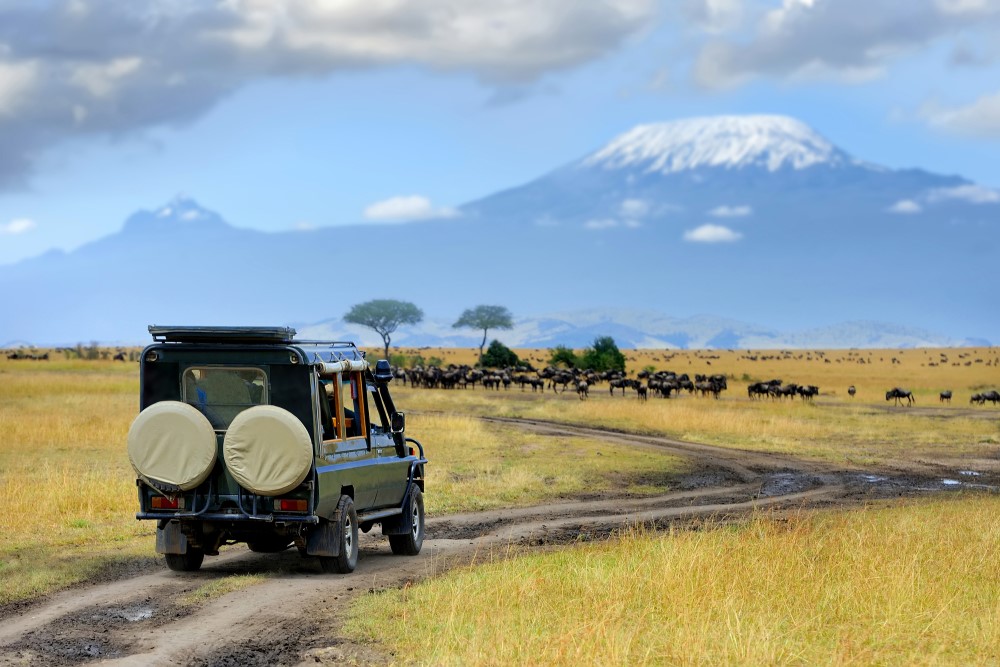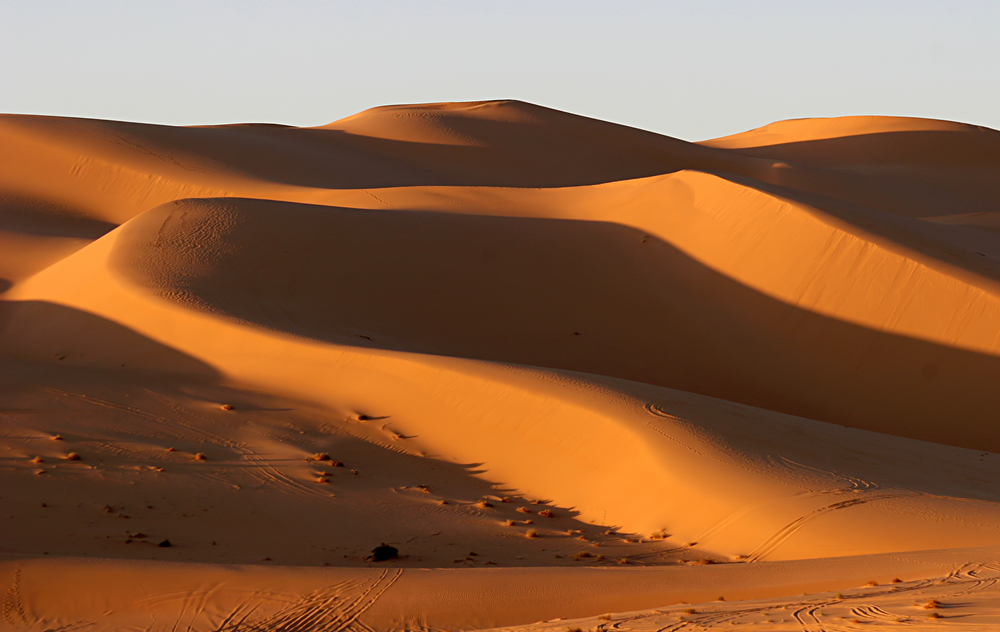 Stone Town in Zanzibar is a UNESCO World Heritage Site best explored on foot. Get lost in its narrow limewashed alleyways and soak up the magic of this unique place.
Stone Town in Zanzibar is a UNESCO World Heritage Site best explored on foot. Get lost in its narrow limewashed alleyways and soak up the magic of this unique place.
Find a rooftop bar to watch the sun sink into the Indian Ocean and the dhows slide past while you sip a cocktail and rest your weary feet.
Our tip is to stay in Stone Town the night before flying on somewhere as it is a convenient 20-minute taxi from the airport (compared to some of the beach resorts which are an hour or more away).
By staying in Stone Town itself for a night (compared to visiting on a day trip from the beach) you can explore more fully, and at your own pace – recharging back at the hotel as and when you need to. There are a cluster of hotels right on the waterfront – fabulous for sunset views and dhow watching. On our last visit we stayed at the Zanzibar Serena Inn. There are also places to stay in the ‘pedestrian’ area.
Set out on your walk either in the early morning when it’s still cool, or late afternoon when golden light bathes the streets. The historic centre of Stone Town is not a particularly big place to explore but we’d recommend allowing yourself at least 3 hours – there is a lot to see. The boundary is marked by busy Creek Road, and the bustling Darajani Market – beyond this, the city becomes a rather ugly sprawl of modern life with towerblocks, offices and apartments spreading east – the extent of which can be seen from the plane as you leave.
We set out from The Serena Inn on the waterfront with no particularly set route.I think this is the best way to enjoy Stone Town so that every time you walk you follow a different path and see different things. Here are just some of the main sights to look out for as you wander.
1.Tippu Tip’s House & Zanzibar’s Doors
Not far from the waterfront and the Serena Inn, you’ll find the private residence – a vast mansion on Suicide Alley – of Tippu Tip, an infamous Arab ivory and slave trader who died in 1905. Tip acquired seven clove plantations in Zanzibar and as many as 10,000 slaves. His house has been crumbling away since the mid-1960s marked by a plaque outside. Although there is no access to the property, the huge and elaborate carved teak door can still be seen from the street and is one of the first landmarks you’re likely to come across as you leave the waterfront.
Zanzibar’s wooden doors tell a story of the people who lived there. As you wander around Stone Town you will begin to notice subtle differences in the doors’ designs. Those with brass studs and an arched top are influenced by Indian culture; rectangular and intricately carved frames, often with script from the Quran and rosettes are Arab; Swahili doors are rectangular too but far more modest in design– they have carvings but no inscriptions. The doors’ carvings offer clues about the original resident – chains are said to symbolise a wealthy slave trader, vines for owners of plantations and waves or ropes were reserved for those involved in the mercantile industry.
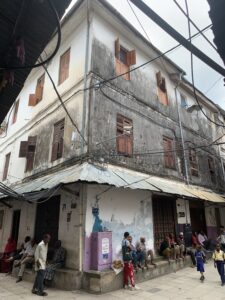 2.Jaws Corner
2.Jaws Corner
Several of Stone Town’s narrow alleyways converge at Jaws Corner – a popular gathering place where local men come to sit and enjoy a strong black Zanzibari coffee. Over the years various shark murals have been painted on the wall giving the meeting place its name. In 2022, when I last visited, the wall had been whitewashed and only a trace of Great White remained…
3.Anglican Cathedral and Slave Market
As many as 50,000 slaves annually are estimated to have passed through Stone Town’s slave market at the peak of the slave trade– the last remaining open slave market in East Africa until it was closed by the British in 1873. In 1879 a cathedral was built on the site as a memorial. It remains an incredibly important historical site reminding us of this dark passage in history. Tours cost $5.
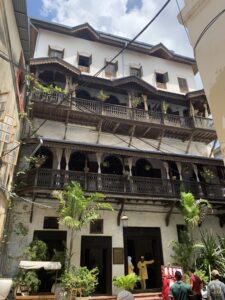 4.Emerson Spice Hotel and Secret Garden
4.Emerson Spice Hotel and Secret Garden
Bold and stylish, this wonderfully restored merchant’s house is now a hotel offering eleven bespoke rooms. I stayed at its sister hotel Emerson on Hurumzi when I first visited Zanzibar back in 1998 – it was then known as Emerson & Green. It’s impossible to miss Emerson Spice Hotel as you wander through the alleyways – you’ll spot the staff in their smart golden robes, and the grand façade towering above you. Interiors are flamboyant and Swahili in style.
The Secret Garden is an open-air restaurant in the courtyard – a lovely cool and atmospheric place with foliage and flowers tumbling down the walls. It’s a great place to stop for a drink or some lunch – the veggie curry is delicious. Make sure you slip through the garden into the lobby of the hotel to use the restroom and take a peek inside this atmospheric building which offers a riad-like tranquillity amidst the hubbub of Stone Town’s narrow streets.
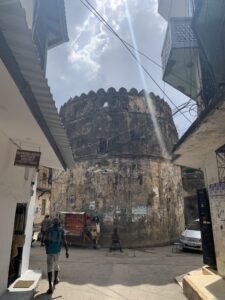 5.Old Fort
5.Old Fort
This is the oldest building in Stone Town, built by the Omani Arabs in 1699 as a defence against the Portuguese. The scale of the place is undeniably impressive. It’s uses have changed over the years from a prison in the 19th Century, the terminal of Zanzibar railways in the early 1900s, to a Ladies Club. Today it is the headquarters of the Zanzibar International Film Festival.
The courtyard and amphitheatre serve as an open air performance venue and you’ll find various curio shops around the perimeter. It is free to wander around the courtyard and gaze up at the ramparts, although be warned – it can get seriously hot with the stone fortifications soaking up the fierce Zanzibari sun – wear a hat!
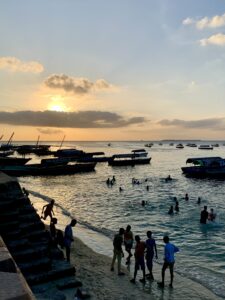 6.Forodhani Gardens
6.Forodhani Gardens
Leaving the Old Fort you’ll see Forodhani Gardens across the road, occupying a wonderful position right on the ocean between the ferry terminal and the beach.
The square is the hub – it is very popular with locals who meet up here to socialise in the evening, eat from the food stalls and watch the sunset.
Look out for a group of teenagers (near the canons on the waterfront) known as the Zanzibar Fun Divers – they perform various perilous acrobatic jumps and dives from the sea wall into the ocean – a sport known as ‘Makachu’. They have amassed quite a social media following (72k).
You’ll also find many tour guides, touts and taxi drivers looking for business in this area.
As the sun sets there are glorious views down along the seafront. Dhows running trips to Prison Island leave from here. Shangani beach is a public beach and the top end near the gardens get very busy as children come out to swim and play football on the sand – there’s a great atmosphere, particularly at sundown when the place really comes alive.
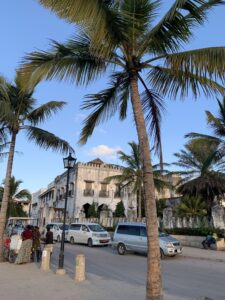 7.House of Wonders
7.House of Wonders
Behind the gardens, across the palm tree lined Mizingani Road you’ll find the House of Wonders.
This is Zanzibar’s most famous landmark. The tallest building in Stone Town was once a place of grandeur. I remember f seeing the distinctive clock tower when I first visited – arriving by ferry from the mainland.
It was built in 1883 as a ceremonial palace for Sultan Barghash, one of six palaces built for him. The front door was made big enough to ‘ride an elephant through it.’ It coined the name ‘House of Wonders’ as it was the first building on Zanzibar to have electric lights, and an elevator. It later became the Museum of History and Culture before closing.
Tragically part of the building collapsed in 2020, including the clock tower. Extensive restoration and stabilization is planned.
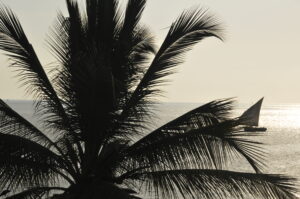 From the House of Wonders you can continue on up Mizingani Road to the ferry terminal and Old Dispensary building or you return to where you started via the beach.
From the House of Wonders you can continue on up Mizingani Road to the ferry terminal and Old Dispensary building or you return to where you started via the beach.
The Old Dispensary is easy to identify – it has a very elaborate design. It was built by a wealthy Ismaili Indian merchant, Tharia Topan in 1887. The colours and style of the building evoke memories of the Caribbean.
If you’re looking for the Freddie Mercury Museum (yes, Freddie was born in Zanzibar) it’s on Kenyatta Road (close to the fort & gardens). Watch out for the scooters!
End your day with a sundowner at Six Degrees South on the waterfront – happy hour is 1900-2100 daily at the rooftop bar.

